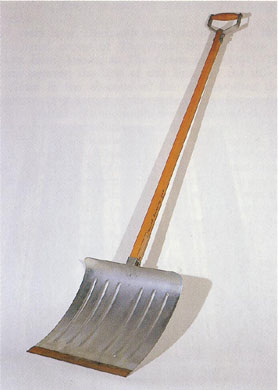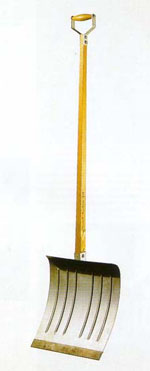
In Advance of the Broken Arm
or
Shovel
 |
| Replica, 1964 |
|
Original Version:
Nov. 1915, New York |
Shovel was the first Readymade to be made by Duchamp after his move to the United States. It seems a rather direct result of this relocation; the American snow shovel was something that Duchamp had never seen before, having moved from France where no such thing was in production. In a sense, this proves quite ironic. This core Readymade was supposedly meant to be an everyday, ordinary object. It succeeded in this aspect for its audience, but in actuality it was a very unfamiliar object for the artist himself.
 |
| Original, Nov. 1915 |
Shovel is inscribed along its lower rim with the following phrase: "In Advance of the Broken Arm/(from) Marcel Duchamp 1915." This "from" conveys that the object came from the artist, but was not necessarily made by him. Duchamp explains that the title of this piece adds "verbal color, as in Why Not Sneeze and most of the other Readymades" (Schwarz 636). It adds word play to this very pure Readymade, illustrating Duchamp's interest in puns.
 |
| Replica, 1945 |
Many scholars have seen sexual undertones in this Readymade. Ramirez notes that the Shovel "is an obvious phallic symbol" (38). Another even more direct association involves Sanskrit. A scholar once mentioned that the Sanskrit word for shovel is "langala," which is almost equal to the term for phallus ("langula"). In Austro-Asiatic languages the same word means both "phallus" and "shovel."
Shovel illustrates just how blurry the line between art and life is when dealing with the Readymades. In Advance of the Broken Arm could easily be mistaken for a simple shovel if it were not suspended from the ceiling. Displacement thus stands as a critical part of the piece. Nesbit writes, "In the ready-mades, Duchamp seized control of the dialogue dictated by the shop window: the model is taken out of circulation, often given an absurd title, hung in a limbo, and effectively silenced. This shovel will never be used, bent, rusted, or fall obsolete" ("Ready-Made" 61-2). The displacement, or lack there of, can prove rather humorous at times. Hamilton explains,
| "Even standing in the corner it wouldn't do, for then it suddenly became a shovel again... When our little exhibition [1945 retrospective of three Duchamp brothers] went on tour, a janitor at a Museum in Minnesota the next winter mistook it for a shovel, as well he might, and went to work on a snowdrift, doing Duchamp's inscription no good" (30). |
 |
| Replica, 1964 |
Replicas:
1) March 1945, New York
Yale University Art Gallery, New Haven, Connecticut
Collection of the Societe Anonyme
2)1963, Stockholm
Moderna Museet, Stockholm
Gift of the Moderna Museets Vanner
Replica by Ulf Linde
3) 1964, Milan
Edition of eight replicas, each 132 cm high, made under Duchamp's supervision from photographs of lost original version
Four additional replicas outside the edition made for the artist, publisher, and museum exhibition